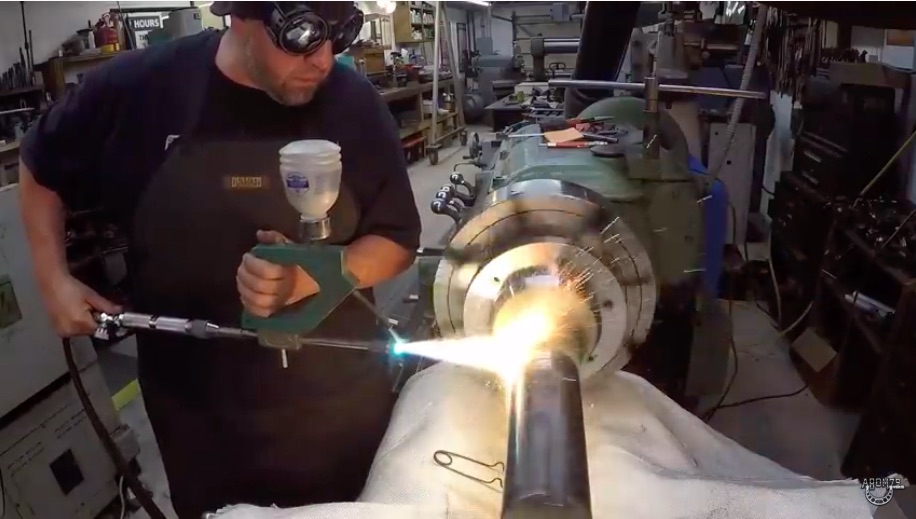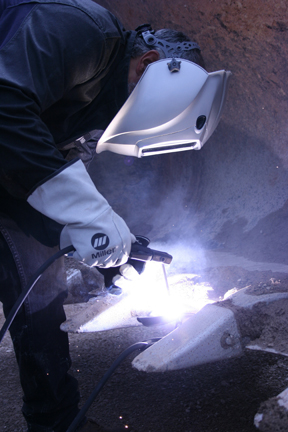Usual Welding Repair Work Issues and Just How to Address Them Efficiently
Welding repair services usually encounter a range of issues that can jeopardize the stability of the end product. Common problems consist of poor penetration, porosity, and imbalance, to name a few. Each problem offers special difficulties that require specific methods for resolution. Recognizing these issues is necessary for welders aiming to boost their results and skills. This conversation will certainly check out these common welding repair concerns and efficient approaches to resolve them.
Poor Penetration
Poor penetration happens when the weld steel fails to fully fuse with the base product, leading to weak joints and possible structural failures. This problem typically originates from not enough warmth input, inaccurate electrode angle, or improper welding speed. Welders might come across inadequate penetration as a result of a mistake of the essential parameters for a specific material density or kind. Additionally, contamination on the base material's surface can hinder effective bonding, aggravating the trouble. To deal with poor infiltration, welders should assure suitable setups on their devices and maintain a tidy work surface area. Routine assessment of welds is suggested to identify any deficiencies early, enabling timely corrections and the prevention of jeopardized structural honesty in bonded assemblies.
Porosity
Porosity is a common issue in welded joints that shows up as tiny gas bubbles caught within the weld steel. This flaw can endanger the honesty of the weld, resulting in reduced strength and prospective failing under stress and anxiety. Montana Mobile Welding and Repair Belgrade Fabrication. Porosity typically arises from contamination, wetness, or incorrect welding techniques, which enable gases to leave right into the liquified weld pool. To attend to porosity, welders should ensure correct surface prep work, maintain a tidy workplace, and use appropriate welding criteria. Additionally, selecting the right filler product and shielding gas can alleviate gas entrapment. Routine inspection and testing of welds can help recognize porosity early, guaranteeing timely restorative actions are taken, therefore maintaining the high quality and reliability of the welded framework
Imbalance
Imbalance in welding can arise from different factors, including improper configuration and thermal expansion. Recognizing the origin is essential for reliable resolution. Several adjustment methods are readily available to straighten parts and ensure architectural integrity.
Reasons for Misalignment
Welding imbalance typically originates from a range of underlying issues that can endanger structural integrity. One key reason is inappropriate fit-up of elements prior to welding, which can lead to spaces and unequal surface areas. Variations in thermal growth during the welding process can additionally lead to distortion, specifically if the materials being signed up with have various coefficients of growth. Additionally, poor fixturing and securing may fail to hold components firmly in position, causing movement during welding. Inadequately maintained devices, consisting of welding devices and tools, might introduce incongruities in the weld grain, additional adding to misalignment. Driver error, stemming from inadequate training or experience, can additionally play a substantial role in developing misaligned welds.

Improvement Methods Offered
Dealing with misalignment properly calls for a mix of corrective methods tailored to the certain concerns at hand. One typical method is making use of fixtures or jigs to hold components in the correct position throughout welding, ensuring constant placement. Furthermore, preheating the products can help in reducing distortion and enhance fit-up. For significant misalignment, mechanical realignment strategies, such as making use of hydraulic jacks or clamps, can be utilized to deal with the position before welding. Post-weld heat therapy may also be required to relieve stress and anxieties brought on by imbalance. Careful assessment and modification throughout the setup phase can avoid imbalance issues from becoming significant troubles, promoting a smoother welding process and enhancing general architectural honesty.
Distortion
Distortion is an usual obstacle in welding that can emerge from numerous variables, including uneven heating & cooling. Comprehending the root causes of distortion is essential for carrying out efficient prevention techniques. Addressing this issue not only boosts architectural stability however additionally improves the overall quality of the weld.
Root causes of Distortion
When based on the extreme warm of welding, materials commonly undergo adjustments that can result in distortion. This phenomenon mainly arises from thermal expansion and contraction throughout the welding procedure. As the weld area warms up, the material increases; upon cooling, it contracts, which can develop inner stresses. In addition, uneven heating across a workpiece can worsen these anxieties, causing warping or flexing. The sort of material also plays a substantial function; steels with varying thermal conductivity and coefficients of development might react in a different way, leading to uncertain distortions. In addition, poor joint design and inadequate fixturing can add to imbalance throughout welding, boosting the probability of distortion. Recognizing these causes is necessary for reliable welding repair work and prevention methods.
Avoidance Techniques
Effective prevention methods for distortion during welding concentrate on controlling heat input and guaranteeing correct joint style. Maintaining a constant warm input assists to decrease thermal development and contraction, which can bring about distortion. Using strategies such as pre-heating the workpiece can additionally decrease the temperature level slope, promoting consistent home heating. In addition, picking proper joint styles, such as T-joints or lap joints, can enhance security and lower anxiety concentrations. Applying correct fixturing to secure the workpieces in location better aids in preserving placement during the welding process. Lastly, staggered welding sequences can distribute heat more equally, stopping localized distortion. By applying these techniques, welders can greatly reduce the chance of distortion and improve the total quality of their welds.
Splitting
Splitting is an usual issue encountered in welding repair services, often arising from various elements such as incorrect cooling rates, material option, or poor joint preparation. The occurrence of fractures can significantly compromise the honesty of the weld, causing possible failures throughout operation. To address this issue, welders should first analyze the origin, making certain that products are compatible and suitably picked for the specific application. Additionally, controlling the air conditioning price throughout the welding procedure is vital; rapid air conditioning can generate stress and result in breaking. Correct joint style and preparation also add to decreasing the danger. Applying these techniques can boost weld top quality and sturdiness, inevitably reducing the likelihood of cracking in ended up weldments.

Insufficient Blend
A significant problem in welding repair services is insufficient blend, which takes place when the weld metal does not adequately bond with the base product or previous weld passes - Belgrade. This flaw can cause weaknesses in the joint, possibly jeopardizing the integrity of the bonded structure. Aspects adding to incomplete fusion consist of inadequate heat input, improper welding strategy, and contamination of the this post surfaces being signed up with. To address this concern effectively, welders need to ensure proper pre-weld cleaning and surface area prep work, in addition to readjust their welding criteria to attain appropriate penetration and blend. Regular evaluation throughout the welding procedure can also help determine insufficient blend early, enabling prompt rehabilitative actions to boost the total top quality of the weld
Overheating
While welding repair services can enhance structural stability, overheating presents a significant obstacle that can result in material degradation. Too much warm throughout welding can change the mechanical residential properties of metals, leading to lowered stamina, boosted brittleness, and warping. This phenomenon is especially crucial in high-stress applications where architectural integrity is vital. Recognizing getting too hot can involve visual inspections for discoloration or distortion, as well as keeping an eye on temperature during the welding procedure. To mitigate the risks connected with getting too hot, welders must utilize ideal techniques, such as regulating heat this article input, changing travel speed, and making use of appropriate filler materials. Furthermore, implementing pre- and post-weld heat therapies can assist bring back product properties and enhance the total quality of the repair work, guaranteeing long-term efficiency and safety and security.
Often Asked Questions
What Are the Typical Indications of a Welding Flaw?

Just How Can I Evaluate My Welds for High quality?
To examine welds for quality, one can use aesthetic evaluations, ultrasonic testing, and radiographic approaches. Each method assures architectural stability, determines flaws, and confirms adherence to defined requirements, eventually enhancing the reliability of the welded joints.
What Safety Safety Measures Should I Take While Welding?
When welding, one must focus on safety by using appropriate individual protective equipment, ensuring correct air flow, safeguarding flammable products away, maintaining a tidy office, and understanding environments to avoid injuries and mishaps.
Can I Repair a Weld Without Remodeling the Entire Joint?
Repairing a weld without redesigning the entire joint is possible, depending on the damages (Welding). Techniques such as grinding, including filler product, or using a welding process can efficiently resolve particular imperfections while maintaining the bordering structure
What Equipment Are Vital for Reliable Welding Repairs?
Vital devices for efficient welding repair work consist of a welding device, cable brush, mill, protective gear, clamps, and filler materials. Each tool plays an essential function in ensuring high quality and safety during the repair work process. Porosity generally occurs from contamination, wetness, or inappropriate welding methods, which allow gases to run away into the liquified weld swimming pool. Improperly maintained tools, consisting of welding equipments and tools, might introduce disparities in the weld grain, further contributing to misalignment. When subjected to the extreme warm of welding, products commonly undertake adjustments that can lead to distortion. Fracturing is a common issue come across in welding fixings, typically resulting from numerous variables such as incorrect additional hints air conditioning prices, product selection, or inadequate joint prep work. A substantial problem in welding repairs is insufficient blend, which takes place when the weld steel does not properly bond with the base material or previous weld passes.